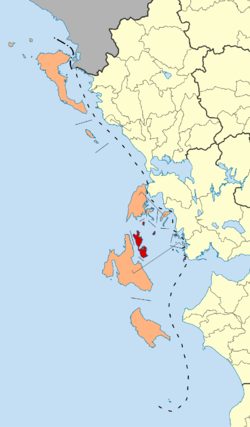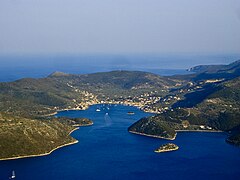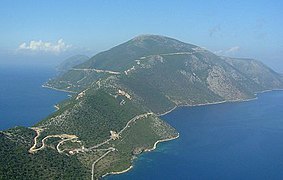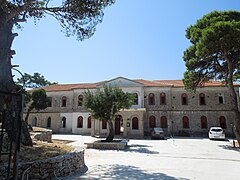Ithaca
|
Municipality of Ithaca Δήμος Ιθάκης (Ιθάκη) |
||
|---|---|---|
|
|
||
| Basic data | ||
| State : |
|
|
| Region : | Ionian islands | |
| Regional District : | Ithaca | |
| Geographic coordinates : | 38 ° 22 ' N , 20 ° 43' E | |
| Area : | 117.8 km² | |
| Residents : | 3,231 (2011) | |
| Population density : | 27.4 inhabitants / km² | |
| Seat: | Ithaca | |
| LAU-1 code no .: | 3401 | |
| Districts : | no | |
| Local self-government : |
1 city district 7 local communities |
|
| Website: | www.ithaki.gr | |
| Location in the Ionian Islands region | ||
Ithaka ( Greek Ιθάκη Ithaki [ iˈθakʲi ] ( f. Sg. )) Is one of the Ionian islands off the west coast of Greece . Together with some uninhabited islets, it forms the municipality of Ithaka ( Δήμος Ιθάκης Dímos Ithákis ), which, as the regional district of Ithaka of the Ionian Islands, sends a representative to the regional council.
The island has an area of 95.8216 km². The highest point is the Niritos with a double peak of 809 and 806 m. The main town and port is the town of Ithaki in the southern part of the island. The island is very green and has many sheltered bays that are especially popular with sailors. The northern and southern parts are separated from each other by the Molos Gulf and are only connected to one another by the narrow, approximately 620 m wide isthmus of Aetos. Numerous buildings were destroyed in an earthquake in 1953 .
Ithaca can be reached today by ferry from Lefkada , Kefalonia , Astakos ( Akarnania ) and Kyllini ( Elis ). In addition to Ithaki, the ferries call at the ports of Frikes in the north of the island and Piso Aetos in the south of the island (west coast).
Administrative division
On the occasion of the municipal reform in 1997 , the previous municipality of Ithaka was merged with the seven rural municipalities of the island to form the new municipality of Ithaka, which encompasses the entire island and numerous secondary islands. The administrative seat of the municipality is Ithaki .
| City district / local community |
Greek name | code | Area (km²) | 2001 residents | Residents 2011 | Villages and settlements, uninhabited islands |
|---|---|---|---|---|---|---|
| Ithaki | Δημοτική Κοινότητα Ιθάκης | 34010001 | 42.197 | 1826 | 1936 | Ithaki, Aetos, uninhabited islands: Arkoudi , Atokos , Vromonas, Drakonera, Karlonisi, Lazareto , Makri, Oxia , Pondikos, Provati |
| Anogi | Τοπική Κοινότητα Ανωγής | 34010002 | 11.623 | 50 | 40 | Anogi, Moni Katharon |
| Exogi | Τοπική Κοινότητα Εξωγής | 34010003 | 4.925 | 42 | 25th | Exogi |
| Kioni | Τοπική Κοινότητα Κιονίου | 34010004 | 8,674 | 171 | 182 | Kioni |
| Lefki | Τοπική Κοινότητα Λεύκης | 34010005 | 8,449 | 56 | 44 | Lefki, Agios Ioannis |
| Perachori | Τοπική Κοινότητα Περαχωρίου | 34010006 | 23.947 | 354 | 343 | Perachori, Lygia |
| Platrithias | Τοπική Κοινότητα Πλατρειθιά | 34010007 | 10.323 | 260 | 295 | Platrithias, Frikes |
| Stavros | Τοπική Κοινότητα Σταυρού | 34010008 | 7.674 | 325 | 366 | Stavros |
| total | 320107 | 33.749 | 2787 | 3231 | ||
fauna
The Ithaca herpetofauna consists of the following species:
Amphibians
Turtles
Geckos
Lizards
- Algyroides moreoticus
- Algyroides nigropunctatus
- Lacerta trilineata
- Podarcis tauricus
- Pseudopus apodus
To sneak
Skinks
snakes
Younger story
The island was conquered by the Normans in 1185 and then belonged to the Palatinate County of Kefalonia and Zakynthos of Margaritos of Brindisi . After his blindness in 1194 it fell to his son-in-law Maio Orsini , who finally submitted to Venice in 1209 . Based on the neighboring island of Kefalonia, with which Ithaca is culturally connected, the island was called Cefalogna Piccola by the Venetians . The earthquake in August 1953 caused great damage .
population
The island now has around 3,000 residents. When Heinrich Schliemann visited the island in 1868, it still had around 12,000 inhabitants. Many of the residents have emigrated over time, mainly to Australia , the United States of America and South Africa .
Sarakiniko Commune
In 1978 a municipality was formed on the Sarakiniko peninsula under the name Sarakiniko Alternatives Leben GmbH . Most of the residents commute to Germany, only about a dozen people live there permanently today (as of 2010). As a follow-up project, the off-grid ecovillage Ecotopia was created in 2010 .
Mythical home of Odysseus
Ithaca is also the name of the homeland island of Odysseus in Homer's epics . Whether Homeric Ithaca corresponds to today's island of Ithaca, which has existed since at least the 5th century BC. BC was so called in ancient written sources, is controversial in research. Heinrich Schliemann believed that he had discovered the palace of Odysseus on Mount Aetos , because some descriptions of Homer's place can be brought into line with the landscape and the summit is fortified with an extensive Cyclopean wall , which suggests a Mycenaean settlement. Schliemann's conclusions are controversial, and another place on the island competes for the ancient palace site.
Wilhelm Dörpfeld held Lefkada for the Homeric Ithaca, since u. a. the topographical information and more extensive geographical statements about the area of Odysseus in Homer make the identification of Lefkada with the Homeric Ithaca probable in his opinion. Among other things, Dörpfeld pointed out that for the localization of the island of Asteris , on which the suitors ambushed Telemachos , only the islet Daskalio could be considered, if the Homeric Ithaca should correspond to today's. Dörpfeld, on the other hand, equated Asteris with the much larger island Arkoudi , south of Lefkada, which, in accordance with Homer's information, would offer two natural harbors and from which one could see the sea well. Dörpfeld also referred to several passages in the Odyssey in which Telemachus asks Ithaka's strangers:
Which [is] the ship you came on? How did the boatmen get
you to Ithaca? What is their name?
Because you didn't come here on foot.
Dörpfeld declined that reaching Ithaka on foot could be a joke by Homer, since a “joke ... completely inappropriate” was in the scene in which Odysseus reveals his true identity to his son. If Homeric Ithaca were equated with today's Ithaca, the passage would make no sense, but it would make sense if it were identical with Lefkada. Even before the Corinthians around the middle of the 7th century BC. Created a navigable canal between Lefkada and the mainland, a shallow strait separated Lefkada from the mainland. The poor could therefore have reached Lefkada on foot and with simple ferries, which would also have brought slaughter cattle across the strait; The rich, on the other hand, would have come by ship. Dörpfeld's view could not prevail in research. Although he found the remains of Mycenaean graves and settlements during excavations, he did not find a palace he had assumed.
The British entrepreneur and amateur historian Robert Bittlestone is looking for the Homeric Ithaca on the Paliki peninsula ( Greek Παλική ) on the west coast of the neighboring island of Kefalonia , as in his opinion the following description from the ninth song of the Odyssey is hardly in harmony with the nature of the island today leaves:
Ithaka's sunny heights are my home; in this
tower Neriton's head rests with rustling tops; and
sown close together all around are many populated islands,
Same, Dulichion and the wooded Zakynthos.
Ithaca lies highest in the sea, up to the fortress,
towards the north; the others are distant to the east and south.
Paliki, on the other hand, is not an independent island today, but a part of Kefalonia ( Dimos Palikis was the official name of the city of Lixouri until 2010 ). However, there are indications that it was once in archaic times . For example, Strabo speaks in the 1st century BC. From a place on Kefalonia that is often flooded by the sea. If Paliki really was an island in its own right, it would come closest to Homer's description.
This theory is supported by the British geologist John Underhill , who studied the rock layers between the Paliki peninsula and Kefalonia. He did not find any solid rock, only sediments and boulders that may have connected the two islands through seismically caused landslides.
The historian Heinz Warnecke also suspects that the Homeric Ithaca is actually Kefalonia. Warnecke bases his thesis on geographical and historical findings: Homer describes Ithaca as the westernmost and highest of the western Greek islands ruled by Odysseus. This description fits Kefalonia much better than Ithaca today. Compared to Kefalonia, Ithaca was much too small and insignificant to be used as a royal seat in a heroic epic.
In the meantime, in the north of Ithaka, near Exogi, the remains of a three-story building with a staircase carved into the rock and a. a. a well discovered and partially excavated. Based on Mycenaean ceramics also found there , the remains are dated to the 13th century BC. Dated. The excavator, Tanasis Papadopoulos, considers the complex to be the remains of a Mycenaean palace and connects it with the palace of the mythical Odysseus described by Homer.
Literary kings of Ithaca
Sons and daughters of the island
- Odysseas Androutsos (1788–1825), hero of the Greek liberation struggle
- Platon Drakoulis (1858–1934), philosopher, writer, politician
- Panagis Lekatsas (1911–1970), writer, journalist
- Lorentzos Mavilis (1860–1912), scholar, poet
- Ioannis Metaxas (1871-1941), dictator
Trivia
The main belt asteroid (1151) Ithaca is named after the island.
literature
- Dietrich Volkmer: Ithaka - the eternal goal - scenes of a journey home . Books on Demand , 2006, ISBN 978-3-8370-3053-2
- Robert Bittlestone: Odysseus Unbound. The Search for Homer's Ithaca . Cambridge University Press, Cambridge 2005.
Web links
- Island of Odysseus ( Memento from April 27, 2010 in the Internet Archive )
- Ithaca poem by Konstantinos Kavafis
- Information of Greek Travel Pages (English)
- Item to discussion about the location of Homeric Ithaca (English)
- Trauminsel revisited: 30 years of Sarakiniko Alternatives Leben GmbH - A documentation by Thomas Schmitt (table of contents and information about the municipality of Sarakiniko)
Individual evidence
- ↑ Results of the 2011 census. ( MS Excel ; 2.6 MB) National Statistical Service of Greece (ΕΛ.ΣΤΑΤ)
- ↑ Ελληνική Στατιστική Αρχή [ΕΛΣΤΑΤ] (Ed.): Στατιστική Επετηρίδα της Ελλάδος (Statistical Yearbook of Greece) 2009 & 2010 . Piraeus 2011, p. 47 .
- ↑ Law 2539/1997, «Συγκρότηση της Πρωτοβάθμιας Τοπικής Αυτοδιοίκησης." ΦΕΚ 244A / December 4, 1997, Άρθρο 1. Σύσταση δήμων και κοινοτήτων. S. 8812. PDF Online (Greek)
- ↑ Ilias Strachinis, Dimitris Aravanis: Additions to the known herpetofauna of the Iceland of Ithaki, Ionian Sea, Greece. In: Herpetozoa. 30 (1/2), Vienna July 30, 2017, pp. 64–66 ( PDF on ZOBODAT ).
- ↑ Thomas-Schmitt-Film.de: ( Memento of the original from July 22, 2010 in the Internet Archive ) Info: The archive link was inserted automatically and has not yet been checked. Please check the original and archive link according to the instructions and then remove this notice. TRAUMINSEL revisited , accessed November 27, 2013
- ↑ Torsten Wahl: The hostages of the commune , Berliner Zeitung, July 17, 2010
- ↑ photovoltaikforum.com
- ^ Wilhelm Dörpfeld : The Homeric Ithaca . In: Leucas. Two essays on Homeric Ithaca . Athens 1905, p. 17 f.
- ^ W. Dörpfeld: Leucas. Two essays on Homeric Ithaca . Athens 1905.
- ↑ Since the Homeric seed has mostly been identified with Kefalonia or a part of it since ancient times, asteris is actually mostly equated with Daskalio in research, although it has no port and the island is only about 140 meters long. However, it is the only island between Kefalonia and Ithaca.
- ^ W. Dörpfeld: Leucas. Two essays on Homeric Ithaca . Athens 1905, pp. 14-17
- ↑ u. a. Homer, Odyssey 1, 172-174; 14,188-190; 16.57–59 (translation by Roland Hampe )
- ^ Wilhelm Dörpfeld: Leucas. Two essays on Homeric Ithaca . Athens 1905, p. 12
- ↑ s. Strabon , Geography 10,458
- ^ Wilhelm Dörpfeld: Leucas. Two essays on Homeric Ithaca, Athens 1905, p. 11 f.
- ↑ Odyssey , ninth song, verses 21-26, translation after Johann Heinrich Voss, edited by E. Gottwein
- ↑ Heinz Warnecke: Homer's Wild West. Stuttgart 2008.
- ↑ Heinz Warnecke: Homer's Wild West. Lecture in the series SWR2 Wissen: Aula. (Broadcast manuscript)
- ↑ medicamina.bplaced.net





